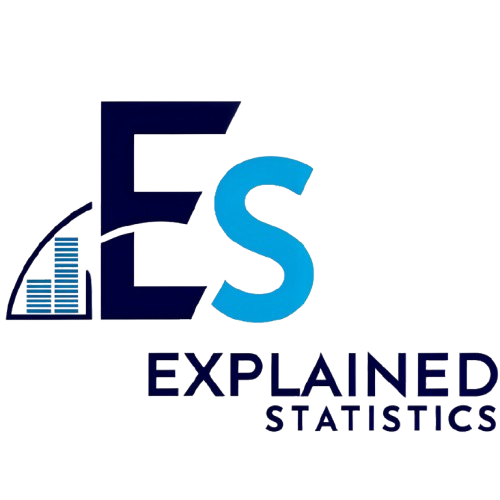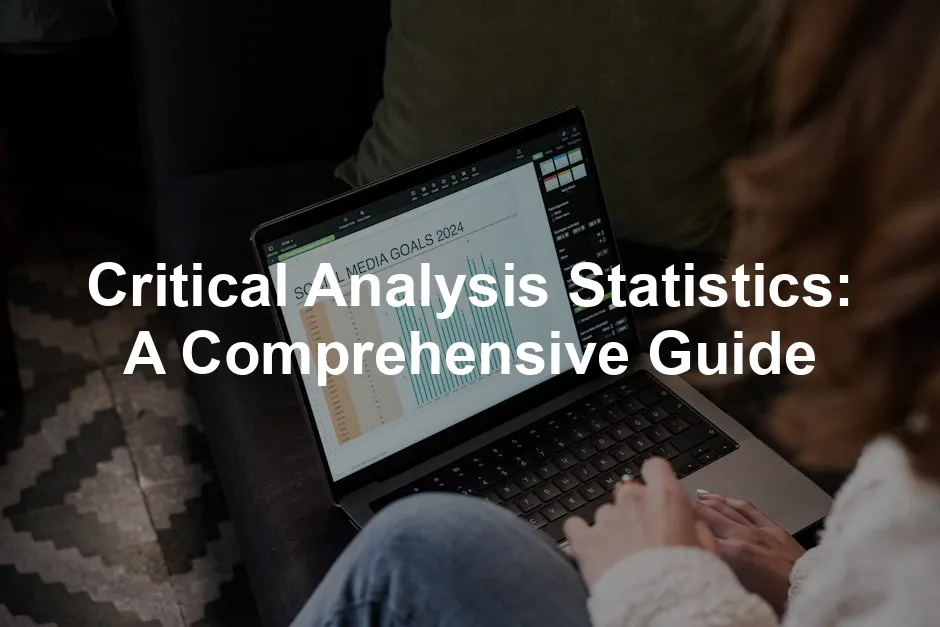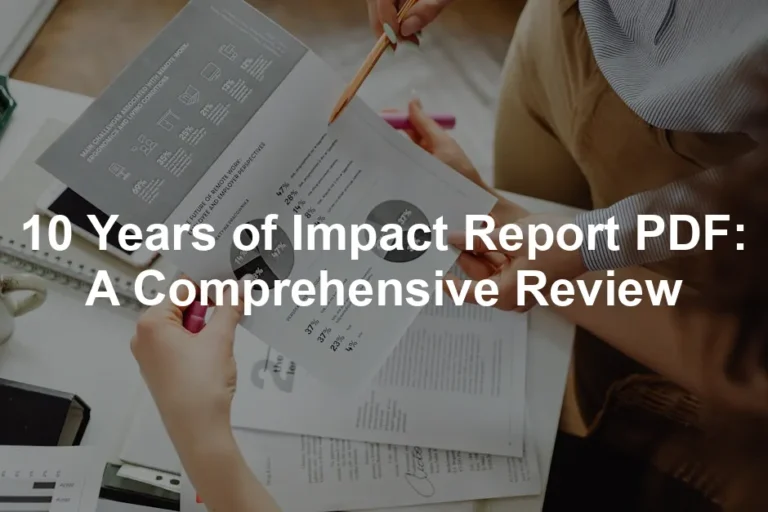Introduction
Statistics isn’t just about crunching numbers. It’s a vital tool for critical analysis across various fields. This article aims to unravel the concept of critical analysis in statistics. We’ll explore its significance, applications, and why it matters in today’s research landscape.
Critical analysis involves evaluating statistical data to determine its validity and reliability. It’s not enough to take numbers at face value. Researchers must ask questions: Are the results trustworthy? Do they reflect reality? This scrutiny is essential, especially in disciplines like healthcare, social sciences, business, and education.
In healthcare, for instance, critical analysis ensures that clinical trials yield reliable results. It helps determine the effectiveness of treatments, guiding medical professionals in decision-making. Similarly, in social sciences, researchers analyze data to understand societal trends and behaviors, ensuring their findings contribute positively to public policy.
If you’re looking to dive deeper into the world of statistics, I highly recommend checking out Statistics for Dummies. It’s a great starting point for anyone who wants to grasp the fundamentals of statistics without getting overwhelmed!
In business, critical analysis of market data empowers companies to make informed decisions. It helps them understand customer preferences, forecast trends, and optimize operations. Education also benefits from this analytical approach, as educators use data to assess student performance and improve teaching methods.
What can you expect from this article? We will break down the fundamentals of critical analysis in statistics, emphasizing its role in research. We’ll clarify what critical analysis entails and explore how statistics support research endeavors. By the end, you’ll appreciate the importance of critical analysis and how it shapes informed decision-making across various sectors.

For a deeper understanding of statistical learning, check out an introduction to statistical learning with python book length.
Understanding Critical Analysis in Statistics
What is Critical Analysis?
Critical analysis in statistics is the systematic evaluation of data to assess its credibility and relevance. It’s about digging deeper than surface-level interpretations. This process is guided by critical thinking—an essential skill that allows researchers to challenge assumptions and scrutinize methodologies.
The importance of critical thinking in analyzing statistical data cannot be overstated. It helps researchers identify potential biases, assess the accuracy of data collection methods, and interpret results with caution. When researchers engage in critical analysis, they can differentiate between correlation and causation, ensuring that conclusions drawn from data are valid.
If you’re interested in enhancing your critical thinking skills, consider reading Critical Thinking: A Beginner’s Guide. It’s a fantastic resource for anyone looking to sharpen their analytical skills!
The Role of Statistics in Research
Statistics is the backbone of research, providing the tools needed to collect, analyze, and interpret data. It supports research by allowing researchers to quantify variables, identify patterns, and test hypotheses. In essence, statistics transforms raw data into meaningful insights.
Accurate data interpretation is crucial. Misinterpretations can lead to flawed conclusions, affecting decisions made in healthcare, policy-making, and business strategies. Therefore, understanding statistical methods and their implications is vital for researchers. This knowledge empowers them to present their findings transparently and responsibly, fostering trust in their work.
If you’re keen on diving into the statistical methods used in research, I suggest checking out The Art of Statistics: Learning from Data. It’s a great read for grasping the intricacies of data analysis.
In summary, critical analysis and statistics are intertwined. Together, they enhance the credibility of research, ensuring that findings are robust and applicable in real-world situations. As we move forward, keep this synergy in mind as we explore the key components of critical analysis in statistics.

Key Components of Critical Analysis in Statistics
Research Question and Hypothesis
A well-defined research question is the starting point for any statistical analysis. It sets the stage for the entire study. The question must be clear, focused, and researchable. A vague question can lead to confusion and misinterpretation of results. Think of it as the compass that guides your research journey. Without it, you’re like a ship lost at sea—definitely not ideal!
Once the research question is established, formulating a hypothesis is the next step. A hypothesis is a specific, testable prediction about what you expect to find in your study. It often takes the form of a statement, such as “There is a significant difference between Group A and Group B.” This statement isn’t just a wild guess; it’s grounded in existing knowledge and literature.
Creating a hypothesis involves several steps. First, review relevant literature to understand existing findings and gaps. Next, consider the variables involved. What are you measuring? What is the expected relationship between them? A good hypothesis is not just a shot in the dark; it’s based on sound reasoning and evidence. By framing your hypothesis correctly, you lay the groundwork for meaningful statistical analysis.
Study Design
In the world of statistics, the study design is like the blueprint for a building. It dictates how the research will be conducted, influencing the validity and reliability of results. There are several types of study designs, each with its strengths and weaknesses.
Randomized Controlled Trials (RCTs) are often considered the gold standard. In an RCT, participants are randomly assigned to either a treatment group or a control group. This randomization minimizes bias and helps establish cause-and-effect relationships. However, RCTs can be expensive and time-consuming. They might also face ethical considerations, especially in healthcare settings.
On the other hand, observational studies provide valuable insights without intervention. These studies can be cross-sectional, cohort, or case-control. Cross-sectional studies assess a specific population at a point in time, offering a snapshot of a situation. Cohort studies follow a group over time to determine how exposures affect outcomes. Case-control studies compare individuals with a condition to those without, identifying potential risk factors.
However, observational studies come with limitations. They can be prone to biases such as selection bias and confounding variables. While they offer great flexibility, they may not always establish causation. Thus, researchers must carefully consider their design choice, weighing the pros and cons against the research question at hand.
If you’re interested in learning more about research design, I recommend Research Design: Qualitative, Quantitative, and Mixed Methods Approaches. It covers various methodologies that can enhance your research skills.

Data Collection Methods
Effective data collection methods are pivotal in ensuring the integrity of your research. Various methods exist, each suited for different types of studies. Surveys, experiments, interviews, and existing datasets are common sources of data.
Surveys are a popular choice for collecting data from a large audience quickly. They can be distributed online or in person, allowing researchers to gather responses on various topics. However, designing a good survey requires careful consideration. Questions must be clear and unbiased to avoid misleading results.
Experiments provide a controlled environment to test hypotheses. Researchers manipulate one or more variables while keeping others constant, observing the effects. This method is particularly effective for establishing causal relationships.
Regardless of the method chosen, appropriate sampling techniques are crucial. Random sampling helps ensure that every individual in the population has an equal chance of being selected. This reduces bias and enhances the generalizability of the findings. Conversely, convenience sampling, where participants are chosen based on availability, can skew results and misrepresent the population.
In summary, the right data collection method, paired with appropriate sampling techniques, is essential for gathering reliable data. A solid foundation in these areas strengthens the overall quality and credibility of statistical analysis, paving the way for sound conclusions.

Statistical Tests and Analysis
Common Statistical Tests
Statistics can feel like a complex maze, but fear not! We’re here to guide you through it. First up on our journey are the common statistical tests: t-tests, ANOVA, and regression analysis. Each test has its own unique purpose, like superheroes in a statistical universe.
T-tests are great for comparing the means of two groups. Think of them as the friendly neighborhood Spider-Man, swinging in to determine if two groups are really different or just hanging out in the same neighborhood. Use a t-test when you have two sets of data and want to see if there’s a significant difference between them.
Next, we have ANOVA (Analysis of Variance). If t-tests are Spider-Man, ANOVA is the Avengers—capable of handling multiple groups at once! When you want to compare means among three or more groups, ANOVA saves the day. It tells you if at least one group is different but won’t tell you which one. For that, you might need a post-hoc test, like a detective solving a mystery.
Finally, we have regression analysis. This is the wise old sage of the statistical tests, helping you understand relationships between variables. Want to know how much your coffee consumption affects your productivity? Regression analysis will guide you through the correlation maze, showing you how one variable influences another. It’s perfect for predicting outcomes based on certain inputs.
Using the right test is crucial. T-tests shine in simple comparisons, ANOVA tackles multiple groups, and regression helps decipher relationships. Choose wisely, and your analysis will be a blockbuster hit!

Interpreting Results
Now that we know our statistical heroes, let’s explore how to interpret their results. This is where the magic happens! Understanding p-values, confidence intervals, and effect sizes is key to unlocking the truth behind the numbers.
P-values are like the magic eight balls of statistics. A p-value less than 0.05 often indicates that your results are statistically significant. This means there’s strong evidence against the null hypothesis, which claims no effect or difference exists. But wait! A small p-value doesn’t mean your results are practically significant. That’s where effect size comes into play. It tells you how meaningful the difference is—not just whether it exists. So, don’t let a tiny p-value fool you into thinking your results are a big deal!
Next up, we have confidence intervals. These nifty tools provide a range of values within which we expect the true population parameter lies. For instance, if a 95% confidence interval for a mean difference is [2, 5], we can be 95% confident that the true mean difference falls between 2 and 5. It’s like a safety net for your estimates, giving you an idea of the precision of your results.
Lastly, it’s essential to distinguish between statistical significance and clinical relevance. Just because your results are statistically significant doesn’t mean they matter in the real world. For example, a new drug might show a statistically significant reduction in symptoms, but if the difference is only slight, it may not be clinically relevant. Always keep your audience in mind, and communicate findings clearly to avoid confusion.
In summary, interpreting statistical results is like piecing together a puzzle. Understand p-values, confidence intervals, and effect sizes to see the bigger picture. Ensure your findings are not only significant but also relevant. Happy analyzing!

Recognizing and Mitigating Bias in Statistical Analysis
Types of Bias
Ah, bias—the sneaky villain of the statistical world. It’s like that friend who always tries to steer the conversation towards their favorite topic! In research, bias can lead to misleading conclusions. Let’s uncover the types of bias that researchers must be wary of.
Selection bias occurs when certain individuals are more likely to be included in a study than others. Imagine a study on exercise habits that only includes gym-goers. This can lead to results that don’t reflect the general population. To combat this, ensure your sample is representative of the population you want to study.
Next is measurement bias. This happens when the data collection method is flawed. For example, if a survey on dietary habits relies on participants’ memory, it could lead to inaccuracies. Using standardized, validated measurement tools helps minimize this bias. Consistency is key!
Then there’s information bias, which arises from incorrect data collection or misreporting. If researchers fail to gather data uniformly, the results can be skewed. Training data collectors and implementing strict protocols can help reduce this type of bias.
Recall bias is particularly relevant in retrospective studies. Participants might struggle to remember past events accurately, leading to skewed data. Consider using existing records for accuracy when possible.
Lastly, confounding bias occurs when an external factor influences both the independent and dependent variables. For instance, if a study examines the relationship between coffee consumption and heart disease, age might also play a role. Researchers should adjust for potential confounders to ensure accurate interpretations.
In the real world, these biases can dramatically affect study outcomes. Consider a study on a new medication that only includes healthy participants. The results might suggest the drug is effective, but what about those who are unwell? This bias can lead to unrealistic expectations and poor clinical decisions.

Strategies to Reduce Bias
Now that we’ve identified the villains, let’s discuss strategies to reduce bias in research design and analysis. First and foremost, randomization is your best friend! In randomized controlled trials (RCTs), assigning participants randomly helps ensure that external factors are equally distributed across groups. It’s like a fair game of chance!
Blinding is another essential strategy. When participants don’t know if they’re receiving the treatment or placebo, it reduces bias in reporting outcomes. Likewise, blinding researchers can minimize bias in data collection. Think of it as keeping the secret of the magician’s tricks!
Using appropriate comparison groups is crucial too. When evaluating a new intervention, ensure you have a proper control group. This helps establish a baseline and allows for meaningful comparisons.
Finally, consider conducting sensitivity analyses. This involves testing how robust your results are to different assumptions or potential biases. It’s like stress-testing your findings to ensure they hold up under scrutiny.
In summary, recognizing and mitigating bias is vital for producing reliable research outcomes. Employ strategies like randomization, blinding, and appropriate comparison groups to enhance the integrity of your studies. With these tools in your arsenal, you can confidently navigate the statistical landscape!

The Importance of Evidence-Based Medicine
Definition and Principles
Evidence-Based Medicine (EBM) is the conscientious use of current best evidence in making decisions about the care of individual patients. It relies heavily on critical analysis, ensuring that healthcare decisions are informed by the most reliable research available. EBM combines clinical expertise, patient values, and the best scientific evidence into a systematic approach to patient care.
At its core, EBM operates on several principles. First, it emphasizes the importance of integrating individual clinical expertise with the best available external clinical evidence. This means that while healthcare professionals bring their unique knowledge and experience to the table, they must also consider established research findings.
Second, EBM encourages a hierarchy of evidence. Randomized controlled trials (RCTs) rank at the top, followed by cohort studies, case-control studies, and expert opinions. This hierarchy helps clinicians determine which studies hold more weight and can influence treatment decisions. The goal is to ensure that patient outcomes are based on solid evidence rather than anecdotal experiences or outdated practices.
If you’re looking to delve deeper into evidence-based practices, I suggest Evidence-Based Medicine: How to Practice and Teach EBM. It’s a comprehensive guide that will enhance your understanding of EBM principles.
Lastly, EBM is not static. It evolves as new research findings emerge. This adaptability is crucial in a field like medicine, where breakthroughs occur regularly. Healthcare providers must stay updated with the latest evidence to provide the best possible care for their patients.

Application in Clinical Practice
Critical analysis plays a pivotal role in applying EBM in clinical practice. By evaluating the quality and relevance of research studies, healthcare professionals can make informed decisions that enhance patient care and improve treatment outcomes.
For example, consider a situation where a physician is deciding whether to prescribe a new medication for hypertension. By critically analyzing recent RCTs comparing this medication to existing treatments, the physician can assess not only the effectiveness but also potential side effects and interactions. This analysis allows the physician to tailor treatment plans to individual patients, considering their unique circumstances and preferences.
Moreover, EBM encourages shared decision-making between healthcare providers and patients. When providing options for treatment, doctors can present the evidence supporting each choice. This transparency fosters trust and empowers patients to participate in their care actively.
Real-life examples abound in EBM’s positive impact. In diabetes management, for instance, studies have shown that patients receiving EBM-guided care experience better glycemic control and fewer complications. Similarly, EBM has transformed the approach to managing chronic pain, leading to more effective and personalized treatment plans that enhance quality of life.
In summary, the importance of evidence-based medicine cannot be overstated. By relying on critical analysis and current research, healthcare professionals can deliver better patient care, leading to improved health outcomes and enhanced patient satisfaction. EBM exemplifies the commitment to continuous improvement in medical practice, ensuring that patients receive the best care possible.

To learn more about biases in statistical analysis, visit overcoming biases in inferential statistics for healthcare studies.
FAQs
What is critical analysis in statistics?
Critical analysis in statistics involves evaluating data to assess its credibility and relevance. It’s a systematic approach that helps researchers question assumptions and scrutinize methodologies. By employing critical thinking, one can effectively differentiate between correlation and causation, ensuring valid conclusions.
Why is critical analysis important in research?
Critical analysis is vital for establishing the validity and reliability of research findings. It ensures that conclusions drawn from data are trustworthy and applicable to real-world scenarios. This process helps identify potential biases, assess data collection methods, and interpret results with caution.
How can bias affect statistical analysis?
Bias can significantly skew results, leading to incorrect conclusions. For instance, selection bias occurs when certain groups are overrepresented or underrepresented in a study. Measurement bias arises from flawed data collection methods. Both can distort findings and impact decision-making.
What are common statistical tests used in research?
Common statistical tests include t-tests for comparing means between two groups, ANOVA for multiple group comparisons, and regression analysis for examining relationships between variables. Each test serves a specific purpose and is chosen based on the research question.
How does critical analysis contribute to evidence-based medicine?
Critical analysis plays a crucial role in evidence-based medicine by ensuring that clinical decisions are informed by high-quality research. It allows healthcare professionals to assess the validity of studies, tailoring treatments to individual patient needs based on reliable evidence. This approach enhances patient care and outcomes by relying on the best available data.
If you’re looking for a comprehensive guide on statistical analysis, I highly recommend The Complete Guide to Statistical Analysis. It’s packed with valuable insights for anyone looking to master statistical methods!
Please let us know what you think about our content by leaving a comment down below!
Thank you for reading till here 🙂
All images from Pexels




